Welcome to the serene world of Japanese indoor gardening. It’s where calm meets style. Adding a bit of nature indoors can make your home a peaceful place. Japanese indoor plants are known for their beauty and clean air. They’re great for homes.
Adding indoor plants for home to your decor can make your space look better. They also improve the air and reduce stress. In this article, we’ll look at the best plants for a calm and welcoming home.
The Art of Japanese Indoor Gardening
Japanese indoor gardening is more than just decoration. It’s a way to improve your well-being. It combines nature, art, and mindfulness for a peaceful home.
The Philosophy Behind Japanese Plant Culture
Japanese plant culture is based on Shinzen. It’s about finding peace between nature and us. This helps make your home calm and connected to nature.
| Principle | Description | Benefit |
|---|---|---|
| Shinzen | Harmony between heaven, earth, and humanity | Promotes balance and serenity |
| Wabi-Sabi | Appreciation for imperfection and impermanence | Encourages mindfulness and acceptance |
| Yin-Yang | Balance of opposites | Fosters harmony and equilibrium |
Why Japanese Plants Are Perfect for Modern Homes
Japanese plants are great for modern homes. They look asthetic and make your environment feel calm. They’re easy to take care of, even when you don’t have much time for care.
Key benefits of Japanese plants include clean air, less stress, and a calm home and environment. With the right plants, your home can be healthier and more peaceful.
10 Best Indoor Japanese Plants for Your Home
Make your home a peaceful oasis with the top 10 indoor Japanese plants. These plants are known for their beauty and meaning. They can make your home look and feel better.
Selection Criteria for Our Top Picks
We picked the top 10 indoor Japanese plants for several reasons. We looked at how well they do indoors, how pretty they are, and their health benefits. These plants are easy to care for, great for beginners and experts alike.
The criteria included:
- Ease of maintenance
- Aesthetic appeal
- Air-purifying qualities
- Cultural significance
| Plant | Ease of Care | Aesthetic Appeal |
|---|---|---|
| Lucky Bamboo | Easy | High |
| Japanese Maple | Moderate | High |
| Bonsai Trees | Challenging | Very High |
Benefits of Bringing Japanese Greenery Indoors
Having Japanese plants at home is good for many reasons. They can make the air cleaner and your space look better. Studies show they can also help you feel less stressed and happier.
“Plants are not just a decoration, they are a necessity for a healthy and happy life.” – Dr. Jane Smith, Horticultural Therapist
Adding Japanese plants to your home brings elegance and calm. Some benefits include:
- Improved air quality
- Enhanced aesthetic appeal
- Reduced stress levels
Choosing the right Japanese plants can make your home peaceful and welcoming. It can help you feel better and more relaxed.
1. Japanese Maple (Acer palmatum) – Miniature Elegance
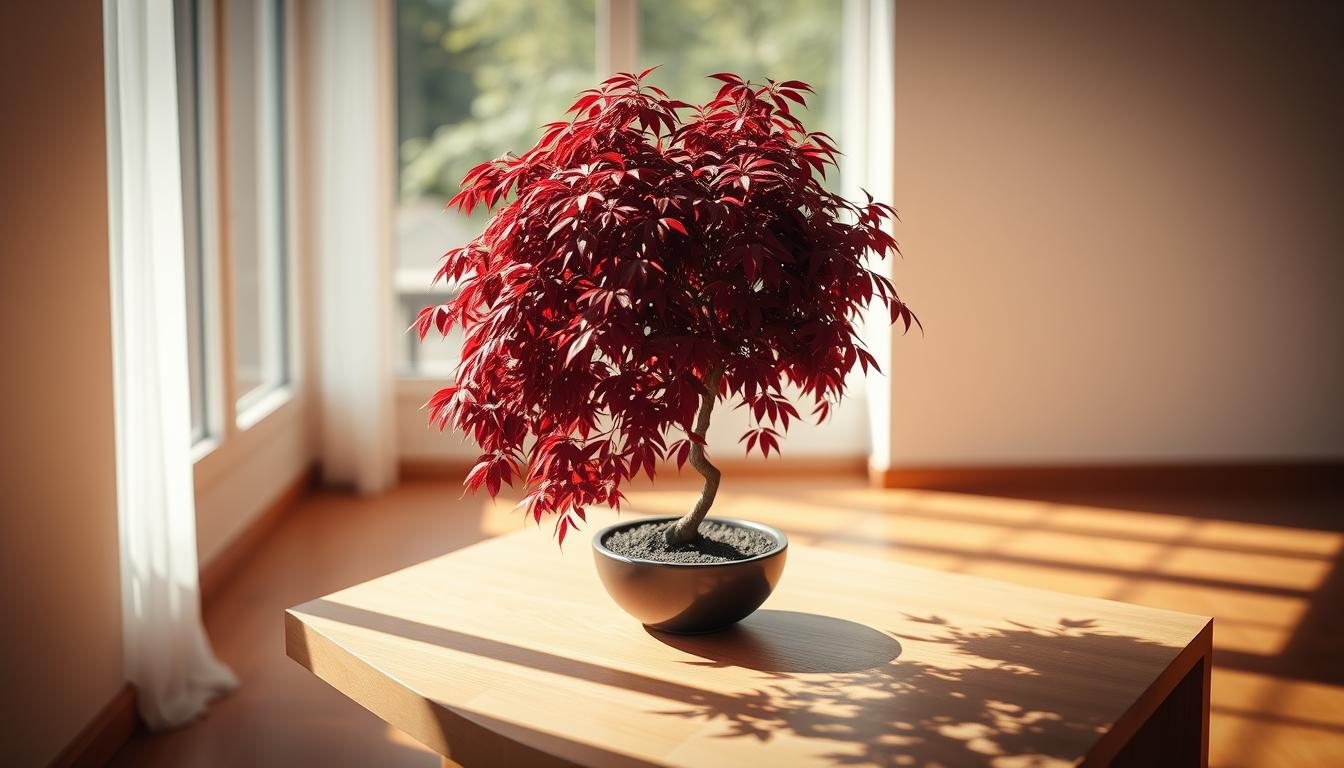
Looking for a plant that’s elegant and versatile? The Japanese Maple is perfect. It has delicate leaves and grows small, great for indoor spaces.
Care Requirements and Growing Tips
To keep your Japanese Maple happy indoors, give it the right spot. It likes bright, indirect light and a steady temperature of 65°F to 75°F (18°C to 24°C). Water it when the top inch of soil is dry. Fertilize it with a balanced, water-soluble fertilizer during the growing season.
Key care tips: Use soil that drains well to avoid root rot. Prune it often to keep its shape and encourage growth.
Styling Ideas for Japanese Maple Indoors
The Japanese Maple’s leaves add elegance to indoor decor. Show it off in a stylish pot or planter. You can group it with other plants or place it as a centerpiece on a shelf or table.
Pair it with plants like ferns or peace lilies for a natural look. This will make your home feel calm and beautiful, adding to your indoor plant decor.
2. Lucky Bamboo (Dracaena sanderiana) – Symbol of Prosperity

Looking to add prosperity to your home? Lucky Bamboo is a great choice. It’s easy to care for and adds elegance to any room.
Water vs. Soil Growing Methods
Lucky Bamboo grows well in water or soil. This lets you pick what works best for you. Water growing is popular for its beauty and ease.
Just put the stalks in a vase with water. Change the water often to keep it clean. Soil growing makes the roots strong and the plant healthy. Use a mix that drains well to avoid soggy soil.
Lucky Bamboo is easy to care for. It’s great for those who are new to plants or are busy. With the right care, it will thrive and bring prosperity to your home.
Feng Shui Placement for Maximum Benefit
For Feng Shui, where you put Lucky Bamboo matters a lot. Place it in the east or southeast for health, wealth, and luck. Don’t put it where it gets too much sun or cold.
Adding Lucky Bamboo to your home can improve its energy. Feng Shui says it attracts good vibes and luck. “Lucky Bamboo is believed to attract positive energy and bring good fortune to those who cultivate it.”
“The presence of Lucky Bamboo in a home or office is believed to bring about a sense of calm and tranquility, while also attracting prosperity and good fortune.” – Feng Shui Expert
3. Bonsai Trees – Living Art Forms
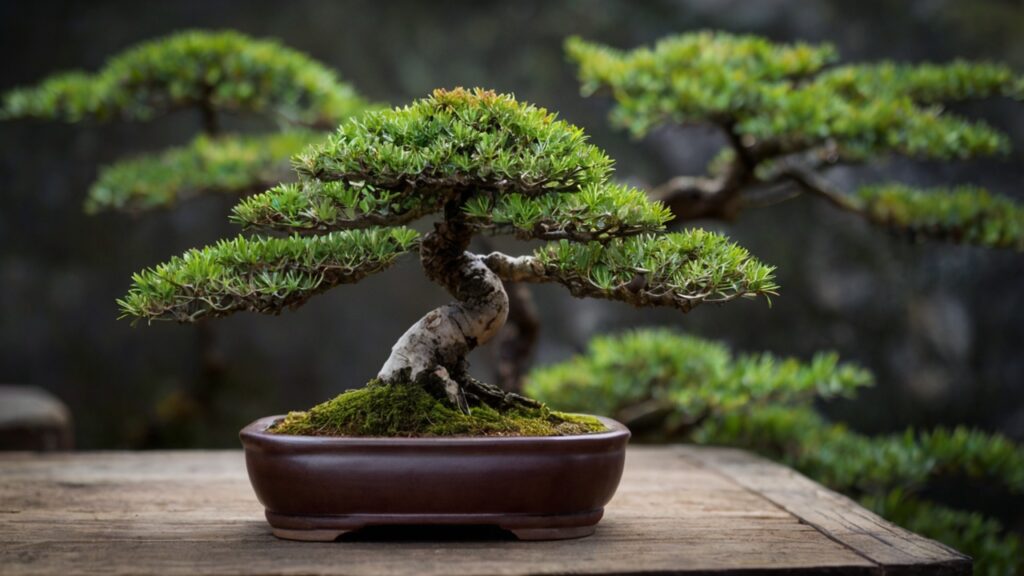
The art of bonsai turns small trees into living masterpieces. Bonsai trees show the patience and dedication of their caretakers. They grow into unique living art over time. Starting your bonsai journey brings joy in shaping and caring for these tiny trees.
Beginner-Friendly Bonsai Varieties
Choosing the right tree is key for beginners. Some trees are easier to care for. Start with:
- Ficus – They have small leaves and do well indoors.
- Juniper – They’re hardy and can handle small mistakes.
- Chinese Elm – They adapt well and are easy to shape.
These trees are tough and easy to shape and prune.
Essential Bonsai Maintenance Techniques
Keeping your bonsai healthy needs regular care. Important steps include:
- Pruning – Pruning keeps the tree’s shape and promotes growth.
- Watering – Knowing when to water is key to avoid overwatering.
- Fertilizing – The right nutrients keep your bonsai healthy and strong.
4. Kokedama (Moss Balls) – Floating Gardens

Looking for a creative way to show off your plants? Try making kokedama. This ancient Japanese art wraps plants in moss, making beautiful balls. These balls can make any room feel peaceful.
Kokedama is not just pretty. It also brings nature indoors. Adding kokedama to your indoor garden makes a unique display. It shows off your favorite plants in a special way.
DIY Kokedama Creation Guide
Making kokedama is a fun DIY project. You need a plant, moss, soil, and twine to start. First, take the plant out of its pot and shape soil around the roots. Then, cover it with moss and tie it with twine. For success, pick the right plant, use good moss, and handle the roots carefully.
- Choose a plant like a fern or small shrub for kokedama.
- Use black and sphagnum peat moss for best moisture.
- Wrap twine tightly to keep moss in place.
Display Options for Kokedama Arrangements
After making kokedama, you can show it off in many ways. You can hang it or put it on a tray. Or, group them for a beautiful display. “The art of kokedama is not just about the individual pieces, but how they come together to create a harmonious whole.” Try different setups to find the best for your space.
5. Japanese Peace Lily (Spathiphyllum) – Serene Beauty
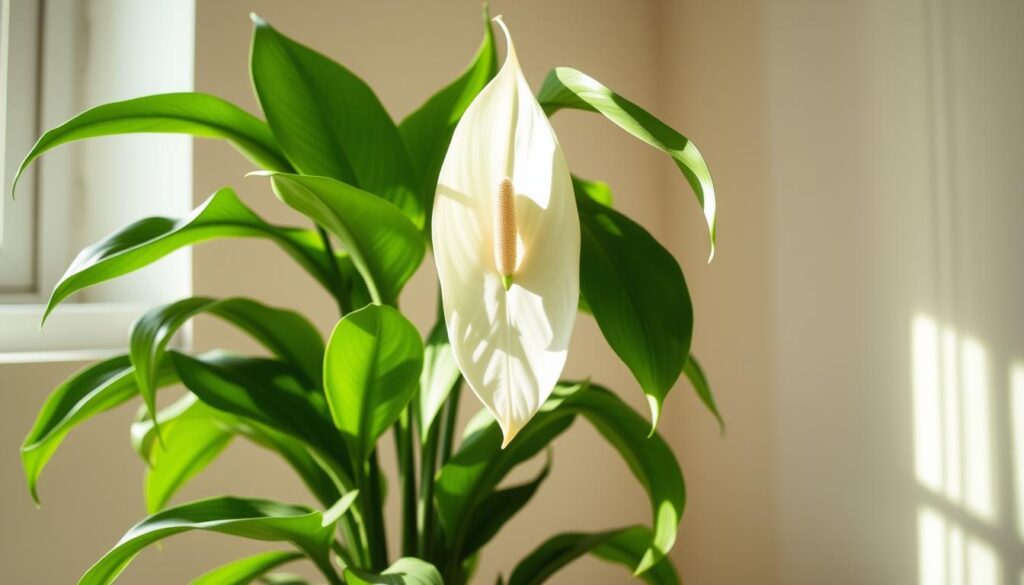
Looking for a plant that brings peace and beauty? The Japanese Peace Lily is perfect. It’s not just beautiful, but also good for your health.
Air-Purifying Properties and Benefits
The Japanese Peace Lily cleans the air. It gets rid of bad stuff like benzene and formaldehyde. This makes your home air cleaner and can help your breathing.
Key Air-Purifying Benefits:
| Toxin Removed | Benefit |
|---|---|
| Benzene | Reduces risk of cancer and anemia |
| Formaldehyde | Decreases risk of respiratory problems |
| Trichloroethylene | Lowers risk of kidney and liver damage |
Troubleshooting Common Peace Lily Problems
Even though the Japanese Peace Lily is easy to care for, it can have problems. You might see yellow leaves, brown tips, or no flowers. These issues usually come from wrong watering, not enough light, or not enough food.
To fix these problems, make sure you’re doing things right. Check how often you water it. Make sure it gets enough light. And only feed it a little during the growing season.
6. Japanese Fern (Cyrtomium falcatum) – Lush Textures

The Japanese Fern adds a natural touch to your home. It has soft fronds and loves low light. This makes it perfect for indoor gardens.
Creating the Ideal Humidity Environment
Japanese Ferns like it humid, between 40-60%. You can use a tray with water and pebbles or a humidifier.
Tips for maintaining humidity: Group plants together. Avoid vents. Mist the leaves often.
Pairing Japanese Ferns with Other Plants
Japanese Ferns go well with peace lilies and snake plants. Make sure each plant gets the right light and water.
Knowing what your Japanese Fern needs helps your indoor garden grow. Pairing it with other plants makes it beautiful.
7. Nandina (Heavenly Bamboo) – Sacred Temple Plant

Looking to add something special to your indoor garden? Nandina, or Heavenly Bamboo, is a great pick. It’s not just beautiful but also holds a special place in Japanese temples.
Indoor Growing Requirements
To grow Nandina indoors, you need to mimic its natural habitat. It loves bright, indirect light and needs well-draining soil. Water it just right, letting the soil dry a bit before watering again. Keep the temperature between 65°F to 75°F (18°C to 24°C) for best growth.
| Condition | Ideal Setting |
|---|---|
| Lighting | Bright, indirect light |
| Watering | Moderate, allowing soil to dry slightly |
| Temperature | 65°F to 75°F (18°C to 24°C) |
Seasonal Color Changes and Appeal
Nandina’s color changes are truly striking. In spring, it starts with a bright red, then turns green in summer. As fall comes, it changes to orange and red, creating a stunning view. This seasonal change makes your indoor space even more beautiful.
8. Camellia Japonica – Flowering Elegance
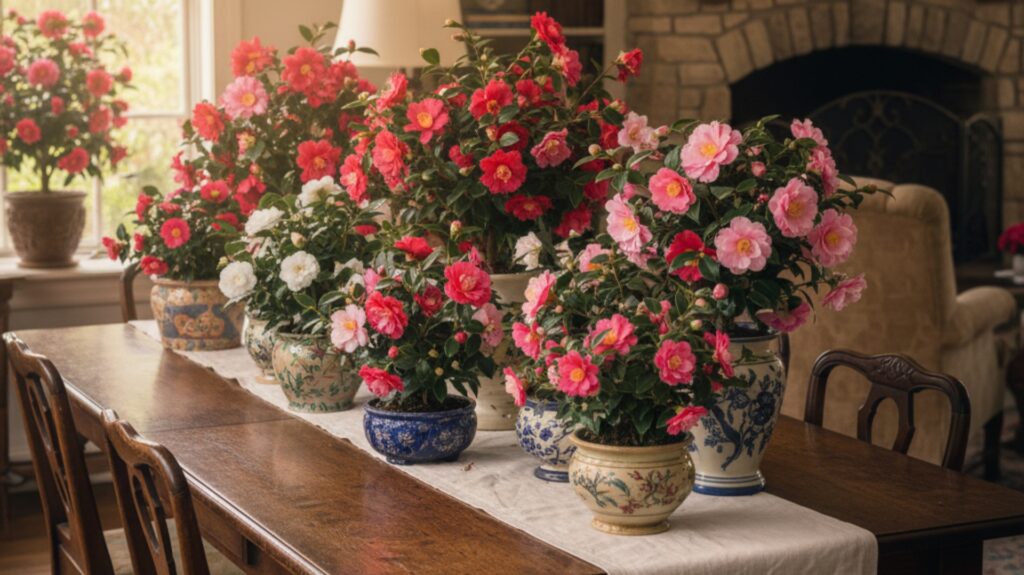
Camellia Japonica is great for a fancy indoor garden. It’s known for its beautiful flowers. It’s also loved for its role in Japanese gardening.
Blooming Cycles and Care
Camellia Japonica blooms from late winter to early spring. It has flowers in pink, white, and red. To make it bloom well, keep it cool and give it filtered sunlight.
Water it regularly but don’t overdo it. Too much water can harm the roots.
Key care tips: Use acidic, well-draining soil. Fertilize often when it’s growing. Prune after it blooms to keep it looking good.
Traditional Japanese Symbolism
In Japan, Camellia Japonica stands for the samurai spirit. It symbolizes long life and loyalty. Its flowers in winter show its strength and dedication.
In Japanese gardens, it’s a key feature. It shows the beauty and strength of nature.
9. Japanese Sago Palm (Cycas Revoluta)
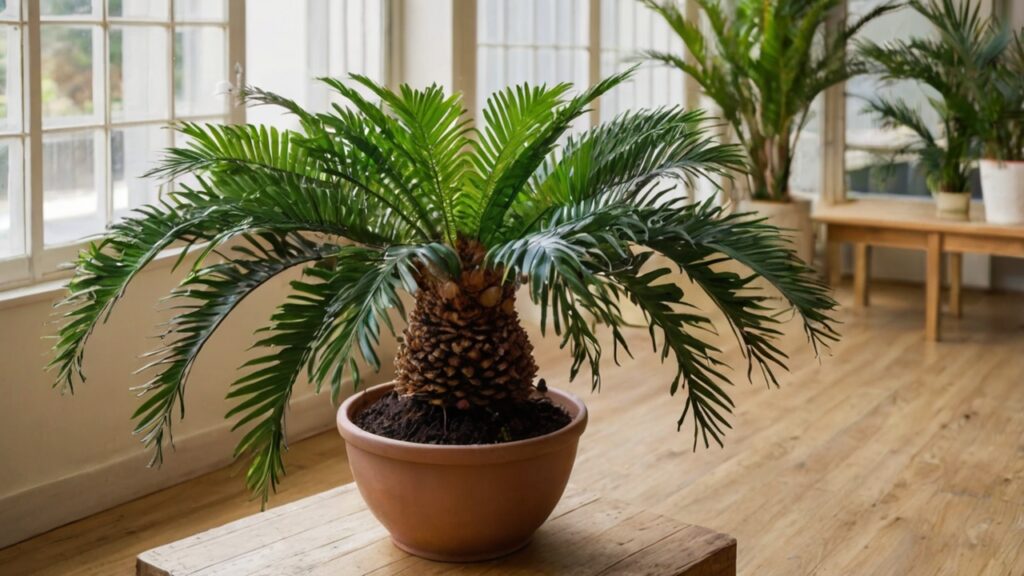
Looking for a plant that’s bold and timeless? The Japanese Sago Palm (Cycas Revoluta) is a great choice. With its dark green, feather-like leaves and sturdy trunk, it adds a tropical touch to your indoor or outdoor space. Despite its palm-like look, it’s actually a cycad, one of the oldest plant families on Earth!
Care Requirements and Growing Tips
The Sago Palm loves bright, indirect sunlight but can also handle some direct light. Keep it in a warm spot between 65°F to 75°F (18°C to 24°C). Water it only when the top few inches of soil feel dry — it doesn’t like soggy roots. During the growing season (spring and summer), feed it with a slow-release palm fertilizer every 2 to 3 months.
Key care tips: Use well-draining sandy soil to prevent root rot. Avoid overwatering, as the plant is drought-tolerant. Wipe the leaves gently to keep them dust-free, and handle it carefully — its fronds can be sharp.
10. Japanese Cast Iron Plant (Aspidistra Elatior)
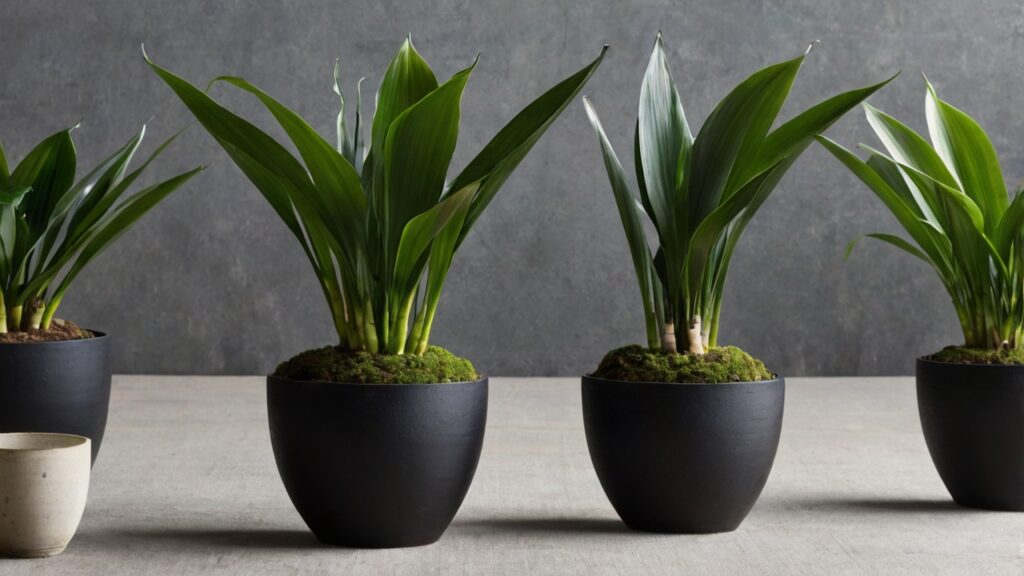
Looking for a plant that’s almost impossible to kill? The Japanese Cast Iron Plant (Aspidistra Elatior) is perfect for you. Known for its tough, glossy green leaves, it adds a touch of calm beauty to any room. It’s ideal for beginners or busy plant lovers who often forget watering.
Care Requirements and Growing Tips
The Cast Iron Plant thrives in low to medium light and even tolerates shade, making it perfect for darker corners. Keep it in a room with temperatures between 60°F to 75°F (15°C to 24°C). Water the plant when the top inch of soil is dry, but avoid overwatering. During the growing season, feed it with a balanced liquid fertilizer once a month.
Key care tips: Use well-draining potting soil to prevent soggy roots. Wipe its leaves occasionally to remove dust. This plant grows slowly, but with a little patience, it can live for years and stay green all year round.
Related Video-
Caring for Japanese Plants in American Homes
To keep your Japanese plants happy in an American home, you need to know their special care needs. Japanese plants are different from what you might be used to. It’s important to adapt to these differences to help them survive.
Adapting to Different Climate Zones
One big challenge is getting used to the different climates in the United States. Plants that love Japan’s weather might find it hard in America’s hot or cold places. Research the specific climate needs of your plants and change your care to match. You can use climate-controlled environments or adjust how often you water and feed them to match their home weather.
- Check the USDA Hardiness Zone for your area
- Choose plants suitable for your zone
- Adjust care routines based on local climate conditions
Sourcing Authentic Japanese Plant Varieties
Finding real Japanese plant varieties can be tough, but it’s key for a true indoor garden. Look for good nurseries or online shops that sell Japanese plants. Be wary of mislabeled plants, and ask where they’re from if you’re not sure. Joining local plant clubs or online forums can also help you find real plants.

By knowing what Japanese plants need and finding real ones, you can make a beautiful indoor garden. It will bring a bit of Japan to your American home.
Conclusion: Creating Your Japanese Plant Sanctuary
Starting your Japanese plant sanctuary is exciting. You’ll mix nature, art, and spirituality at home. With the right plants and care, your space will be calm and beautiful.
Japanese plants in your home are more than pretty. They help you feel calm and connected to nature. Caring for them is like meditation, helping you relax and feel new.
Creating a Japanese garden at home is peaceful. It’s a calm spot in a busy city. Begin today and enjoy the calm your sanctuary brings.
FAQ
What are the best indoor Japanese plants for beginners?
Lucky Bamboo, Japanese Peace Lily, and Japanese Fern are great for beginners. They are easy to care for and can grow well in many conditions.
Can I grow Japanese plants outdoors in the US?
Some Japanese plants can grow outside in the US, but it depends on the climate and plant. Check what your plant needs to see if it can grow outside where you live.
How do I care for a Bonsai tree indoors?
Bonsai trees need the right light, water, and humidity indoors. Prune and train it often to keep its shape. Also, repot it when needed to keep the roots healthy.
Are Japanese indoor plants air-purifying?
Yes, many Japanese plants, like the Japanese Peace Lily, clean the air. They remove toxins and pollutants, making the air better indoors.
